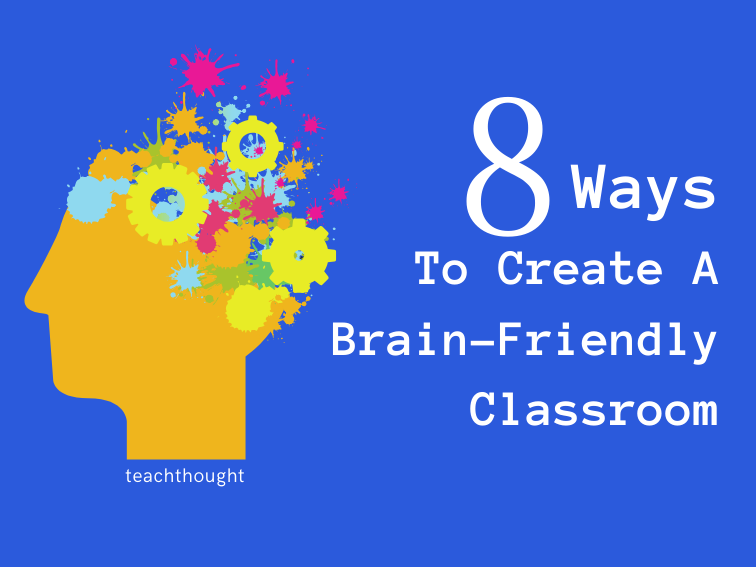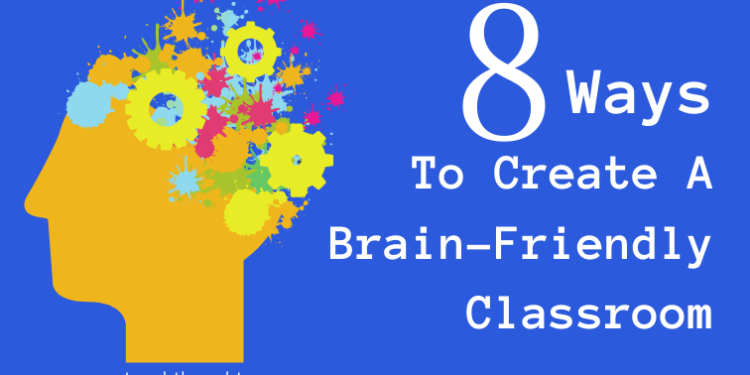

by Judy Willis and TeachThought Staff
The idea of a ‘brain-friendly’ classroom isn’t a frequent talking point in education, but maybe it should be.
How to create such a classroom isn’t immediately obvious. Although it is valuable for teachers to be familiar with neuroscientific research and pass relevant findings along to education stakeholders, it is crucial that educators use classroom strategies that reflect what we know about the brain and learning.
So how can teachers create environments where anxiety is low while providing enough challenge and novelty for suitable brain stimulation? How can you create a classroom that works in a way the brain ‘likes’ to learn? This is obviously a multi-faceted concept involving sensory input, task creation, sequencing, mindset, tone, student-to-student and student-to-teacher interactions, and so on, not to mention the far more impactful experiences students have at home. Trauma or even simply an ongoing state of stress in a dysregulated environment all shape the brain and its functions–the brain you as a teacher are trying to help them use to learn.
8 Ways To Create A Classroom That Works Like The Brain Likes To Learn
1. Make learning clear–and clearly relevant
When a lesson is overly abstract or seems irrelevant to students. Teachers can reduce this type of stress by making the lesson more personally interesting and motivating. Ideally, students should be able to answer the question, “Why are we learning about this?” at any point in a lesson. Teachers can find valuable background materials and human interest connections in textbooks published in the 1990s, before many publishers dropped such information to make room for practice test questions.
The internet is a source of many teacher-shared lesson plans and links to websites that provide resources for student activities and information databases that bring the more fact-heavy lessons to life. Consider our fill-in-the-blank prompts for project-based learning where students can, with your help, create their own projects.
It is not always possible to explain the immediate relevance of every lesson. In math, for example, students must master certain skills before they can go on to investigate larger, more clearly relevant topics. One way to increase the emotional connection is by adapting word problems so that they include the names of students, popular celebrities, historical figures, or sports heroes. Similarly, problems about interest rates can relate to purchasing something the students would want to buy, such as a book, new phone, or clothes, for example. Students can learn about decimal place values by calculating batting averages to the thousandth place.
Language arts teachers can combine lessons on formal letter writing with a study of ethics or advertising. Students select a television commercial or print ad they judge to be misleading and write a letter expressing that opinion to the company in question. Students can compare historical fact and fiction by reading texts, examining primary sources, and viewing movies. In science classes dealing with the differences between mixtures and solutions, students can predict which liquids in their homes are mixtures and which are solutions. At home, they test their predictions by seeing which items are in separate layers until shaken.
Or instead of just studying facts about pollution, students can learn to take and test water samples (). When a lesson or block of lessons is full of facts to memorize, students will often feel less stress when they see an intrinsic reward for their efforts, such as using the facts they’ve mastered as a tool for participating in a more appealing activity. For example, when students know the metric to standard measurement conversions, they can ‘translate’ a recipe from a cookbook that uses metric measures into the quantities they need in U.S. standard measurements to prepare cookie dough in class.
2. Give their brains a break
Just like adults, students can reduce stress by enjoying hobbies, time with friends, exercise, or music. Even though schools are shortening recess, physical education, art, drama, and even lunchtime to add more time for core subjects, teachers can give students a three-minute vacation to reduce stress. Any pleasurable activity used as a brief break can give the amygdala a chance to cool down and the neurotransmitters time to rebuild.
Meditation apps can be useful, too.
3. Help students create positive associations
The brain works via feedback loops which create associations over time. So help students create positive associations with school: With content areas, letter grades, tests, or simply the idea of school itself.
Eliminating all suffering, stress, and negativity from students’ lives is impossible. However, even if previous classroom experiences have led to associations that link certain activities, such as memorizing multiplication tables, to a stress response from the amygdala, students can benefit from revisiting the activity without something negative happening. By avoiding stressful practices like calling on students who have not raised their hands, teachers can dampen the stress association. Students can develop positive associations with multiplication by practicing it with a positively reinforcing strategy.
For example, they might first review the table for multiplying by eight, then fill in blanks on a worksheet and immediately check each written answer with a calculator. If the answer is correct, the student experiences instant positive reinforcement. If the answer is incorrect, the student sees the right answer on the calculator—a much more pleasurable experience than hearing a classmate call out the answer before the student can even begin to compute it.
4. Create visible progress and achievements
By creating visible progress and achievements–using additive grading or even a kind of ‘checklist’ that students can see becoming completed–dopamine is released and self-efficacy has a chance to develop.
In a similar way, students can build on their neurochemical memories of positive feelings if they have opportunities to recognize and savor their successes. A posted ‘Personal Goal Achievement’ list, for example, acknowledges all students’ successes. Students set personal goals, such as learning a specific multiplication table, and their names go on this list when they achieve their goals.
Unlike the more typical competitive list of scores or lists of students who have mastered specific skills, this goal achievement list includes only the names of students who have met their goals, not the actual goals themselves.
5. Help students to learn to prioritize
Not all information or tasks are equally important. As adults, in critical or high-stress situations, the quicker the brain can identify what’s ‘most important,’ the better its chance of success or survival. Separating more and less important data is a hugely important critical thinking and survival skill.
It is helpful for teachers to guide students in learning how to prioritize information—how to decide what facts are worthy of writing down and reviewing when studying. When teachers demonstrate and explain how they determine which facts are important, students see how to make those judgments for themselves as they read texts and study. Helping students learn how to prioritize and therefore reduce the amount of information they need to deal with is a valuable way to promote a ‘brain-friendly’ classroom.
6. Leverage inquiry-based learning and a growth mindset
While repetition is a proven brain-based learning strategy (practice makes perfect), it’s not always that simple. Thanks to dopamine release and the consolidation of relational memories, students are more likely to remember and understand what they learn if they find it compelling or have a part in figuring it out for themselves. In addition, when students have some choices in the way they will study or report on something, their motivation will increase and stress will diminish. They will be more accepting of their errors, motivated to try again, and less self-conscious about asking questions.
A rational, flexible, and optimistic mindset can help students build resiliency through appropriate ‘dosing’ of short-term stressors that inevitably arise in the classroom, whether through traditional, direct instruction models or a model designed to take advantage of the benefits of inquiry-based learning.
Whatever you want to call it: Growth mindset, failing forward, or taking ‘genius risks,’ mindset is everything in life, and mastering this can disarm ‘school’ and help students cultivate a love of learning.
7. Reduce stress
Classrooms can be a safe haven where academic practices and classroom strategies provide students with emotional comfort and pleasure as well as knowledge. When teachers use strategies to reduce stress and build a positive emotional environment, students gain emotional resilience and learn more efficiently and at higher levels of cognition. Unsurprisingly, brain-imaging studies support this relationship.
If students feel safe, have clear goals, visible progress, and the ability to identify what’s most important, stress can be minimized. Further, if they are allowed to–and are supported in–curiosity-based inquiry, are given breaks, and are able to replace negative associations with positive associations, the brain will be in a state far more conducive to learning.
8. Don’t overstress short-term memory
The Cognitive Load theory explains more, but in short, this amounts to teaching in a way that honors the limitation of the short-term ‘working’ memory compared to the more able ‘long-term’ memory. This reduces stress, which as demonstrated above, both decreases neurological capacity and increases negative associations for learning.
References Andreasen, N. C., O’Leary, D. S., Paradiso, S., Cizaldo, T., Arndt, S., Watkins, G. L., et al. (1999). The cerebellum plays a role in conscious episodic memory retrieval. Human Brain Mapping, 8(4), 226–234. Christianson, S.A. (1992). Emotional stress and eyewitness memory: A critical review. Psychological Bulletin, 112(2), 284–309. Chugani, H. T. (1998). Biological basis of emotions: Brain systems and brain development. Pediatrics, 102, 1225–1229. Dulay, H., & Burt, M. (1977). Remarks on creativity in language acquisition. In M. Burt, H. Dulay, & M. Finocchiaro (Eds.), Viewpoints on English as a second language. New York: Regents. Kohn, A. (2004). Feel-bad education. Education Week, 24(3), 44–45. Krashen, S. (1982). Theory versus practice in language training. In R. W. Blair (Ed.), Innovative approaches to language teaching (pp. 25–27). Rowley, MA: Newbury House. Pawlak, R., Magarinos, A. M., Melchor, J., McEwen, B., & Strickland, S. (2003). Tissue plasminogen activator in the amygdala is critical for stress-induced anxiety-like behavior. Nature Neuroscience, 6(2), 168–174. Shadmehr, R., and Holcomb, H. H. (1997). Neural correlates of motor memory consolidation. Science, 277, 821–825. Sowell, E. R., Peterson, B. S., Thompson, P. M., Welcome, S. E., Henkenius, A. L., Toga, A. W., (2003). Mapping cortical change across the human life span. Nature Neuroscience, 6, 309–315. Thanos, P. K., Katana, J. M., Ashby, C. R., Michaelides, M., Gardner, E. L., Heidbreder, C. A., et al. (1999). The selective dopamine D3 receptor antagonist SB-277011-A attenuates ethanol consumption in ethanol preferring (P) and non-preferring (NP) rats. Pharmacology



















